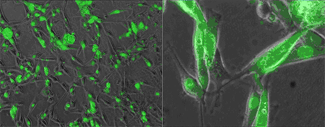The use of RNA interference as therapeutic tool

2007 Nobel Prize Award to Drs. Andrew Fire and Craig Mello just culminates 8 years of research on RNA interference field that have revolutionized research tools as well as basic knowledge on molecular and cellular biology.
RNA interference is a molecular mechanism present in all eukaryotic cells, from plants to mammals, in which small fragments of RNA (siRNAs) are able to inhibit messenger RNA (mRNA) of homologous sequence and then, specifically inhibit gene expression.
The existence of this mechanism inside cells allows for the introduction of siRNAs to specifically inhibit the desired gene, becoming a useful and generalized research tool. In addition, specific inhibition of a gene may be considered from a therapeutic point of view. For example, our laboratory was one of the first on demonstrating the efficiency of RNA interference to inhibit Human Immunodeficiency Virus (HIV) targeting host-expressed genes, such as main HIV coreceptors: CCR5 and CXCR4 (1).
Beyond current limitations to transform RNA molecules into possible therapeutic drugs, some doubts have appeared about stimulation of non-specific effects. Mammalian cells have pathogen detection mechanisms, including sensors that may recognize RNA molecules. Then, if a RNA interference-based treatment would induce a response, perhaps inflammatory, remains unclear.
In this work (2), we have compared the efficiency of siRNAs targeting HIV coreceptor CCR5 to inhibit target gene, HIV replication and the capacity of stimulating a cellular immune response, measured as cytokine (proteins produced by cells which modulate biological responses) secretion.
We observed that all siRNAs specifically inhibited CCR5 and HIV replication. In addition, flow cytometry allow us for simultaneous detection of cytokine secretion in cells treated with siRNAs. As a result of this screening, we detected that interleukins (a kind of cytokines) IL-6 and IL-8 increased their secretion in the presence of specific siRNAs.
There are promising data about the possibility of using RNA interference as a therapeutic tool. Nevertheless, it has been demonstrated that siRNAs with a specific sequence may stimulate inflammatory responses in target cells. Knowledge of molecular mechanisms involved may lead to the identification of more safety siRNAs with non-inflammatory sequences.
References
(1) Martinez MA, Gutierrez A, Armand-Ugon M, Blanco J, Parera M, Gomez J, Clotet B, Este JA. "Suppression of chemokine receptor expression by RNA interference allows for inhibition of HIV-1 replication". AIDS. 2002 Dec 6;16(18):2385-90.
(2) Pauls E, Senserrich J, Bofill M, Clotet B, Este JA. "Induction of interleukins IL-6 and IL-8 by siRNA". CLIN EXP IMMUNOL. 2007 Jan;147(1):189-96.

